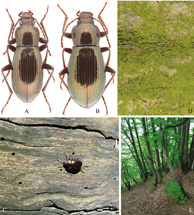Abstract
The present state of the invasive population of Odocnemis aurichalcea (Adams, 1817) (Coleoptera: Tenebrionidae) in North Caucasus is studied. This species is widespread in Transcaucasia and has entered Nalchik and Nartkala towns (North Caucasus, Kabardino-Balkaria, Russia) possibly during urban greening where it is mentioned in these localities since at least the middle of the 20th century. Nothing was known about the status of this invasive population for 54 years.
A rich population of this species was discovered in the outskirts of Nalchik in a natural beech forest in 2022. The species is naturalized in the North Caucasus, but inhabits only a very narrow, isolated range in this region. Diurnal activity, the response of adults to high temperature and humidity, habitat and trophic associations, and current distribution of the species in the North Caucasus are assessed. Taxocenes of tenebrionids from the tribe Helopini, including O. aurichalcea, were described. We establish that imagoes of the species occupy a narrower ecological niche in the invasive range under natural conditions, than in the native range, inhabiting exclusively beeches and feeding on algae of the genus Desmococcus F. Brand, 1925 (Chlorophyta: Trebouxiophyceae).
References
- Byzova Y. B. & Gilyarov M. S. 1956. Soil dwelling larvae of the tribe Helopini (Coleoptera, Tenebrionidae). Zoologichesky Zhurnal 35: 1493–1509 (in Russian).
- Green J. 1951. The food of Cylindronotus laevioctostriatus (Goeze) (Col., Tenebrionidae) and its larva. Entomologist’s Monthly Magazine 87: 19.
- Nabozhenko M. V. 2001. On the classification of the tenebrionid tribe Helopini, with a review of the genera Nalassus Mulsant and Odocnemis Allard (Coleoptera, Tenebrionidae) of the European part of CIS and the Caucasus. Entomological Review 81(8): 909–942.
- Nabozhenko M. V. 2020. New nomenclatural and taxonomic acts, and comments. Tenebrionidae: Helopini, pp. 26–27. In: Catalogue of Palaearctic Coleoptera. Volume 5, Revised and updated second edition. Tenebrionoidea (D. Iwan and I. Löbl, editors). Brill, Leiden, 945 pp. https://doi.org/10.1163/9789004434998
- Nabozhenko M. V. & Artokhin K. S. 2017. Description of the larva of Nalassus (Helopondrus) sareptanus (Allard, 1876) and a position of the subgenus Helopondrus Reitter, 1922 in the system of the tribe Helopini (Coleoptera: Tenebrionidae). Proceedings of the Russian Entomological Society 88(1): 72–79.
- Nabozhenko M. V., Gagarina L. V. & Chigray I. A. 2022a. A new Nalassus Mulsant, 1854 (Coleoptera: Tenebrionidae) from Transcaucasia with a key to species from the Greater Caucasus and notes on the taxonomy, distribution, bionomics and trophic relations. Acta Zoologica Academiae Scientiarum Hungaricae 68(2): 119–158. https://doi.org/10.17109/AZH.68.2.119.2022
- Nabozhenko M. V., Gagarina L. V., Chigray I. A. & Nabozhenko S. V. 2022b. Trophic relations and ecological niches of darkling beetles of the genus Nalassus Mulsant, 1854 (Coleoptera: Tenebrionidae) in the Caucasus and description of a new species from Abkhazia. South of Russia: ecology, development 17(3): 16–34 (in Russian). https://doi.org/10.18470/1992-1098-2022-3-16-34
- Nabozhenko M. V. & Gurgenidze L. N. 2006. Description of the larva of Cylindrinotus gibbicollis Faldermann, 1837 and notes on the classification of the subtribe Cylindrinotina Español, 1956 (Coleoptera, Tenebrionidae: Helopini). Caucasian Entomological Bulletin 2(1): 79–82. https://doi.org/10.23885/1814-3326-2006-2-1-79-82
- Nabozhenko M. V., Kalashian M. Yu. & Mazmanyan M. A. 2021а. The faunistic review of darkling beetles (Coleoptera: Tenebrionidae; excluding Alleculinae) of Armenia and partly the Nakhichevan Autonomous Republic of Azerbaijan with new records and taxonomic notes. Caucasian Entomological Bulletin 17(2): 425–450. https://doi.org/10.23885/181433262021172-425450
- Nabozhenko M. V. & Keskin B. 2016. Revision of the genus Odocnemis Allard, 1876 (Coleoptera: Tenebrionidae: Helopini) from Turkey, the Caucasus and Iran with observations on feeding habits. Zootaxa 4202(1): 1–97. https://doi.org/10.11646/zootaxa.4202.1.1
- Nabozhenko M. V., Keskin B., Alpagut Keskin N., Gagarina L. V. & Nabozhenko S. V. 2021b. Two new species and new records of lichen-feeding darkling beetles (Coleoptera: Tenebrionidae: Helopini) from Turkey with notes on bionomics and trophic relations. Zootaxa 5057(1): 69–86. https://doi.org/10.11646/zootaxa.5057.1.4
- Nabozhenko M. V., Keskin B. & Nabozhenko S. V. 2017. Life forms and strategies of lichen-feeding darkling beetles (Coleoptera, Tenebrionidae: Helopini). Entomological Review 97(6): 735–746. https://doi.org/10.1134/S0013873817060045
- Nabozhenko M. V., Keskin B. & Papadopoulou A. 2020. Two new species and new records of darkling beetles of the tribe Helopini from Turkey and Cyprus (Coleoptera: Tenebrionidae). Acta Entomologica Musei Nationalis Pragae 60(2): 411–417. https://doi.org/10.37520/aemnp.2020.25
- Nabozhenko M. V. & Kolov S. V. 2016. Invasive species among darkling beetles of the tribe Helopini (Coleoptera: Tenebrionidae). Caucasian Entomological Bulletin 12(1): 109–110. https://doi.org/10.23885/1814-3326-2016-12-1-109-110
- Nabozhenko M. V., Lebedeva N. V., Nabozhenko S. V. & Lebedev V. D. 2016. The taxocene of lichen-feeding darkling beetles (Coleoptera, Tenebrionidae: Helopini) in a forest-steppe ecotone. Entomological Review 96(1): 101–113. https://doi.org/10.1134/S0013873816010115
- Nabozhenko M. V., Ntatsopoulos K., Gagarina L. V., Chigray I. A., Lagou L. J. & Papadopoulou A. 2021c. Helops glabriventris glabriventris (Coleoptera: Tenebrionidae), one of the primary consumers of corticolous lichens in the coniferous forests of Cyprus: bionomics, trophic associations and description of larvae. Annales zoologici 71(4): 767–778. https://doi.org/10.3161/00034541ANZ2021.71.4.004
- Nabozhenko M. V., Papadopoulou A., Chigray I. A., Ntatsopoulos K., Makris Ch. & Gagarina L. V. 2022c. Morphological variability, bionomics and trophic associations of the rare Cypriot endemic Odocnemis intrusicollis (Seidlitz, 1895) (Coleoptera: Tenebrionidae). Caucasian Entomological Bulletin 18(1): 83–91. https://doi.org/10.23885/181433262022181-8391
- Nabozhenko M. V. & Steiner W. E. Jr. 2021. Doyenellus Nabozhenko and Steiner, a new genus of darkling beetles of the tribe Helopini (Coleoptera: Tenebrionidae) from North America. Proceedings of the Entomological Society of Washington 123(3): 564–588. https://doi.org/10.4289/0013-8797.123.3.564
- Nikitsky N. B. 2016. Darkling beetles (Coleoptera: Tenebrionidae) of Moscow Region. Caucasian Entomological Bulletin 12(1): 117–130 (in Russian). https://doi.org/10.23885/1814-3326-2016-12-1-117-130
- Temreshev I. I., Childebaev M. K. & Ormanova G. Zh. 2014. To the biology and distribution of some species of beetles (Insecta, Kazakhstan. Kazakh National University Bulletin. Ecology series 40(1/1): 424–426.


